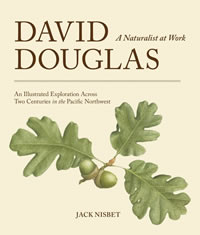 Jack Nisbet’s first book about David Douglas (“The Collector” from 2009) was a very popular, journal-like life chronology of the intrepid plant explorer. The enthusiastic response led the author to realize “…I had only begun to touch the dynamic worlds he [Douglas] saw. So I went back on the trail, revisiting places he had described, checking on species of flora and fauna he had collected, following any lead that might reveal additional facets of his career and character.”
Jack Nisbet’s first book about David Douglas (“The Collector” from 2009) was a very popular, journal-like life chronology of the intrepid plant explorer. The enthusiastic response led the author to realize “…I had only begun to touch the dynamic worlds he [Douglas] saw. So I went back on the trail, revisiting places he had described, checking on species of flora and fauna he had collected, following any lead that might reveal additional facets of his career and character.”
The result is a new book, “David Douglas: A Naturalist at Work.” Instead of a year-by-year account, this is a delightful collection of essays that explores themes as they played out over Douglas’s entire, all-too-short career. Several chapters explore the different groups of people he worked or lived amongst including Native Americans, fur traders, sea farers, and members of the scientific community in England and North America. He did his best to fit in with all and this may explain much of his success as a collector–his eager personality encouraged others to share their knowledge or provide help with explorations.
This new book also incorporates observations from current day researchers that are influenced by Douglas almost two centuries later. For example, he was very enamored with the Garry Oak (Quercus garryana) and the communities it formed in the Pacific Northwest. Present day biologist Peter Dunwiddie has tried to understand why these communities are so rare today. While Dunwiddie concludes there are several factors, the most important is “…the way Native Americans throughout the region systematically set fire to these open oak woodlands,” a practice that did not continue after the early 19th century.
Excerpted from the Summer 2013 Arboretum Bulletin.
 The Orchard Mason Bee by Bellingham author Brian Griffin has long been my go-to book on this subject, but from just across the border in Coquitlam, B.C., is a slightly newer book (2002) on these fascinating garden helpers. “Pollination with Mason Bees” by Margriet Dogterom, takes a bit more of a do-it-yourself approach to creating and maintaining your bee nests, but if you’re interested in this subject, I’d recommend referring to both books.
The Orchard Mason Bee by Bellingham author Brian Griffin has long been my go-to book on this subject, but from just across the border in Coquitlam, B.C., is a slightly newer book (2002) on these fascinating garden helpers. “Pollination with Mason Bees” by Margriet Dogterom, takes a bit more of a do-it-yourself approach to creating and maintaining your bee nests, but if you’re interested in this subject, I’d recommend referring to both books.
Excerpted from the Summer 2013 Arboretum Bulletin.
“It’s a Jungle Out There!” is a collection of essays by Cass Turnbull from the time of the founding of Plant Amnesty. It give some perspective and appreciation for the success of her efforts in educating the public and professionals on proper tree and shrub care. While not available to borrow, this book is worth looking at for its history and, especially, the charming diagrams.
Excerpted from the Spring 2013 Arboretum Bulletin.
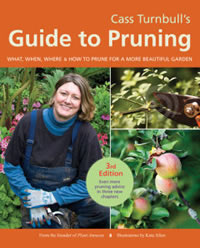 Cass Turnbull needs no introduction to our readers and a new book by her is a cause for celebration. Her “Guide to Pruning” is now available in its 3rd edition with three added chapters, including a much needed essay on Taming the Native-Plant Garden. She also addressed an impressive list of new plants not considered in the earlier editions, including “whackables” such as Lavatera and Perovskia. Oh, how I wish I had read about the dangers of whacking too soon–before making my mid-February cutbacks in my own garden.
Cass Turnbull needs no introduction to our readers and a new book by her is a cause for celebration. Her “Guide to Pruning” is now available in its 3rd edition with three added chapters, including a much needed essay on Taming the Native-Plant Garden. She also addressed an impressive list of new plants not considered in the earlier editions, including “whackables” such as Lavatera and Perovskia. Oh, how I wish I had read about the dangers of whacking too soon–before making my mid-February cutbacks in my own garden.
Excerpted from the Spring 2013 Arboretum Bulletin.
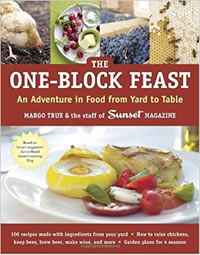 From a publisher a bit out of the region but very familiar to us all is The One-Block Feast by Margo True and the staff of Sunset Magazine. Essentially this is a scrapbook of the an on-going experiment to grow, harvest, prepare, and cook a full menu, all from very local sources–the Menlo Park, California campus of this long-time fount of wisdom for gardeners throughout the west.
From a publisher a bit out of the region but very familiar to us all is The One-Block Feast by Margo True and the staff of Sunset Magazine. Essentially this is a scrapbook of the an on-going experiment to grow, harvest, prepare, and cook a full menu, all from very local sources–the Menlo Park, California campus of this long-time fount of wisdom for gardeners throughout the west.
While one must make modifications for the Pacific Northwest (a calendar of regionally adjusted planting and harvesting dates in the appendix will help), you can’t help but come away from reading this book full of ideas. The staff formed teams by food type, and weren’t afraid to tackle almost anything from honey to cheese, or beer to olive oil. I thought the stories of Team Salt and Team Escargot were the most intriguing.
Excerpted from the Spring 2013 Arboretum Bulletin.
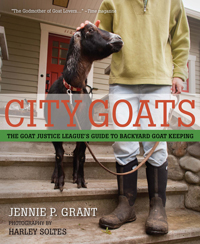 Jennie P. Grant brings a full measure of enthusiasm to “City Goats,” a combination how-to manual, goat keeping manifesto, and love story, made all the better by its Seattle setting. While much of the care-giving information would apply to goats anywhere, the author’s campaign to legalize her herd is especially compelling because of its local connections.
Jennie P. Grant brings a full measure of enthusiasm to “City Goats,” a combination how-to manual, goat keeping manifesto, and love story, made all the better by its Seattle setting. While much of the care-giving information would apply to goats anywhere, the author’s campaign to legalize her herd is especially compelling because of its local connections.
I’m not likely to start my own herd, but I couldn’t help getting hooked by the exploits and personalities of Brownie, Snowflake, Maple, and Eloise. Is this a gardening book? Perhaps not, as the author makes it very clear that your goats and your roses are not good companions. However as the model of the urban farm continues to flourish, you may embrace having your own source of milk and veggies, from securely separated sites, of course.
Excerpted from the Spring 2013 Arboretum Bulletin.
 “Garlic! Grow West of the Cascades” is a charming and infectious little book–that will make you eager to grow lots of this culinary staple. At least, that was my reaction as Frank Parente has an enthusiasm rarely matched by other garden writers. Based on Whidbey Island, but channeling his garden loving, Italian ancestors on both sides of his family tree, he writes to “…cover some pointers that will ensure success in wet and humid Western Washington.”
“Garlic! Grow West of the Cascades” is a charming and infectious little book–that will make you eager to grow lots of this culinary staple. At least, that was my reaction as Frank Parente has an enthusiasm rarely matched by other garden writers. Based on Whidbey Island, but channeling his garden loving, Italian ancestors on both sides of his family tree, he writes to “…cover some pointers that will ensure success in wet and humid Western Washington.”
You will need these pointers, as the many varieties of garlic require specialized handling for optimum results. But don’t worry; the author takes you carefully through the many selections. He also spares no detail on soil preparation, planting, harvesting, curing, and storing, all supplemented with his instructive photographs and diagrams. You’re in good hands!
Excerpted from the Spring 2013 Arboretum Bulletin.

“From the Hands of a Weaver” is a history of basket making on the Olympic Peninsula, edited by Jacilee Wray. Gardening was an important part of this craft as “…sophisticated techniques conducted by indigenous cultures altered the landscape, the species composition, and individual plants, ensuring that the highest-quality basketry materials were continuously available for use.”
Several plants were used in this craft, ranging from the mighty cedars (Thuja plicata) to more humble beargrass (Xerophyllum tenax), but all required intimate knowledge of these plants for the best results. I found the practices used by the different tribes, from plant selection and harvest to the design and production of the baskets, very engaging.
Excerpted from the Spring 2013 Arboretum Bulletin.
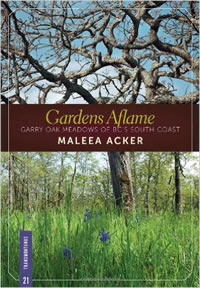
Gardens have taken many forms, depending on the time and culture nurturing them. “Gardens Aflame” considers the gardens created by the indigenous people of the greater Victoria area before the arrival of Europeans. At first, we might not recognize these spaces as gardens, but the Garry Oak (Quercus garryana) meadows were carefully maintained to provide valuable camas roots (Camassia quamash and C. leichtlinii), a staple of the native diet.
Maleea Acker takes a keen interest in the history of these meadows and the efforts to preserve and restore them. As one would expect, these are under threat from expanding development and invasive species. But another challenge comes as the native people can no longer provide the management that kept more aggressive native species (especially Douglas-fir, Pseudotsuga menziesii) from encroaching.
“Meadows were kept clear by the Coast Salish for thousands of years before the arrival of Europeans, and served as a food source for many First Nations up and down the west coast and into the Interior.” While camas was the main crop, other plants were also harvested, and the gardens became important places for people to gather, just as they are today.
Excerpted from the Spring 2013 Arboretum Bulletin.

“Edible Landscaping” is not your typical vegetable gardening book. You will not find an A-Z encyclopedic listing of popular vegetables, nor is there much cultural information specific to each crop. Instead, this is a garden design book with an eye to making edible plants the key feature.
Author Senga Lindsay, a landscape designer and gardener in North Vancouver, B.C., challenges and encourages you, the home gardener, to take charge of your garden’s appearance and assumes that you don’t want your “…yard to look like a ‘dog’s breakfast’–messy, unkempt and utilitarian.” After outlining basic planning steps, she presents fifteen different model gardens, each with detailed plans, lists of needed supplies, and step-by-step procedures for installation.
These plans range from the traditional row garden to green roofs and walls to parking strips. Your garden may need to satisfy a gourmet chef, or accommodate a disabled gardener, or engage young children–all are addressed with the same level of detail. While you can follow one plan to the letter, the elements from the plans can easily be blended as needed.
Excerpted from the Spring 2013 Arboretum Bulletin.
 Jack Nisbet’s first book about David Douglas (“The Collector” from 2009) was a very popular, journal-like life chronology of the intrepid plant explorer. The enthusiastic response led the author to realize “…I had only begun to touch the dynamic worlds he [Douglas] saw. So I went back on the trail, revisiting places he had described, checking on species of flora and fauna he had collected, following any lead that might reveal additional facets of his career and character.”
Jack Nisbet’s first book about David Douglas (“The Collector” from 2009) was a very popular, journal-like life chronology of the intrepid plant explorer. The enthusiastic response led the author to realize “…I had only begun to touch the dynamic worlds he [Douglas] saw. So I went back on the trail, revisiting places he had described, checking on species of flora and fauna he had collected, following any lead that might reveal additional facets of his career and character.” The Orchard Mason Bee by Bellingham author Brian Griffin has long been my go-to book on this subject, but from just across the border in Coquitlam, B.C., is a slightly newer book (2002) on these fascinating garden helpers.
The Orchard Mason Bee by Bellingham author Brian Griffin has long been my go-to book on this subject, but from just across the border in Coquitlam, B.C., is a slightly newer book (2002) on these fascinating garden helpers.  Cass Turnbull needs no introduction to our readers and a new book by her is a cause for celebration. Her “Guide to Pruning” is now available in its 3rd edition with three added chapters, including a much needed essay on Taming the Native-Plant Garden. She also addressed an impressive list of new plants not considered in the earlier editions, including “whackables” such as Lavatera and Perovskia. Oh, how I wish I had read about the dangers of whacking too soon–before making my mid-February cutbacks in my own garden.
Cass Turnbull needs no introduction to our readers and a new book by her is a cause for celebration. Her “Guide to Pruning” is now available in its 3rd edition with three added chapters, including a much needed essay on Taming the Native-Plant Garden. She also addressed an impressive list of new plants not considered in the earlier editions, including “whackables” such as Lavatera and Perovskia. Oh, how I wish I had read about the dangers of whacking too soon–before making my mid-February cutbacks in my own garden. From a publisher a bit out of the region but very familiar to us all is The One-Block Feast by Margo True and the staff of Sunset Magazine. Essentially this is a scrapbook of the an on-going experiment to grow, harvest, prepare, and cook a full menu, all from very local sources–the Menlo Park, California campus of this long-time fount of wisdom for gardeners throughout the west.
From a publisher a bit out of the region but very familiar to us all is The One-Block Feast by Margo True and the staff of Sunset Magazine. Essentially this is a scrapbook of the an on-going experiment to grow, harvest, prepare, and cook a full menu, all from very local sources–the Menlo Park, California campus of this long-time fount of wisdom for gardeners throughout the west. Jennie P. Grant brings a full measure of enthusiasm to “City Goats,” a combination how-to manual, goat keeping manifesto, and love story, made all the better by its Seattle setting. While much of the care-giving information would apply to goats anywhere, the author’s campaign to legalize her herd is especially compelling because of its local connections.
Jennie P. Grant brings a full measure of enthusiasm to “City Goats,” a combination how-to manual, goat keeping manifesto, and love story, made all the better by its Seattle setting. While much of the care-giving information would apply to goats anywhere, the author’s campaign to legalize her herd is especially compelling because of its local connections. “Garlic! Grow West of the Cascades” is a charming and infectious little book–that will make you eager to grow lots of this culinary staple. At least, that was my reaction as Frank Parente has an enthusiasm rarely matched by other garden writers. Based on Whidbey Island, but channeling his garden loving, Italian ancestors on both sides of his family tree, he writes to “…cover some pointers that will ensure success in wet and humid Western Washington.”
“Garlic! Grow West of the Cascades” is a charming and infectious little book–that will make you eager to grow lots of this culinary staple. At least, that was my reaction as Frank Parente has an enthusiasm rarely matched by other garden writers. Based on Whidbey Island, but channeling his garden loving, Italian ancestors on both sides of his family tree, he writes to “…cover some pointers that will ensure success in wet and humid Western Washington.”

